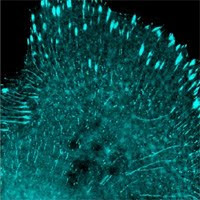From AlleleNews
Compared to the generation of other tissue types, adipogenesis is relatively well studied because of the long availability of mouse cell line 3T3-L1 that can be readily differentiated into white adipocytes upon a simple treatment of a few chemicals. For human adipogenesis cell models, either mesenchymal stem cells (MSCs) from bone marrow or other tissues or adipose-derived stromal vascular cells18 (ADSVCs) could be derived into fat cells. However, these cells have limited potential for expansion for continued studies.
Using iPS cells for tissue development has been a hot topic in many fields of developmental biology. Although one could transfect or transduce iPSCs, it is still often necessary to grow the stem cells into some type of progenitor cells through 3-D suspension culture as embryonic bodies. In a recent Nature Cell Biology paper, Ahfeldt and colleagues in Cowan lab created MSCs from RiPSCs generated by the Luigi Warren mRNA method, then derived them into either white adipose tissues (with lentivirus carried PPARG2) or brown (PPARG2–CEBPB–PRDM16) adipose tissues. It is particularly interesting that brown fat tissues, often considered the “good fat”, could be derived in a dish. This study will open doors for further use of the footprint-free mRNA-derived iPSCs for virtually unlimited supply of precursor cells for in vitro differentiation.
News and Views: http://www.nature.com/ncb/journal/v14/n2/full/ncb2430.html#/references
Original article: http://www.nature.com/ncb/journal/v14/n2/full/ncb2411.html
Saturday, February 18, 2012
Friday, February 10, 2012
Opportunities for business with Allele Biotech
AlleleBlog: http://blog.allelebiotech.com/2012/02/opportunities-for-business-with-allele-biotech/
Allele Biotech is known for staying on the edge of biological research fronts when it comes to developing new technologies into useful tools. Our research also has far-reaching implications and potential applications outside of the traditional biomedical research reagent field. Some of these technologies were the results of researchers interacting with the Allele scientific team, who wanted Allele to help realize their potentials. If you are interested in investing, co-developing, or trading in our areas of expertise, please email us at oligo@allelebiotech.com.
1) A novel method of discriminating and/or detecting mismatched polynucleotide populations in a sample, or determining the relative abundance of the species contained in the sample based on the changes in the relative ratios following a critical treatment. This technology, subject of a current patent application, can provide great benefits in polynucleotide-based diagnosis.
2) A technology on how to utilize the light-absorbing capabilities of certain light-absorbing proteins against damaging lights, or in cosmetic or beauty products. It is also a subject of a filed full patent.
3) Products that relate to detecting swine flu with novel antibodies of high specificity and stability. The antibodies have been tested in academic molecular biology labs in ELISA and strip formats.
4) Nanotechnology products that can be immediately applied to prevent citrus diseases on farms.
Allele Biotech is known for staying on the edge of biological research fronts when it comes to developing new technologies into useful tools. Our research also has far-reaching implications and potential applications outside of the traditional biomedical research reagent field. Some of these technologies were the results of researchers interacting with the Allele scientific team, who wanted Allele to help realize their potentials. If you are interested in investing, co-developing, or trading in our areas of expertise, please email us at oligo@allelebiotech.com.
1) A novel method of discriminating and/or detecting mismatched polynucleotide populations in a sample, or determining the relative abundance of the species contained in the sample based on the changes in the relative ratios following a critical treatment. This technology, subject of a current patent application, can provide great benefits in polynucleotide-based diagnosis.
2) A technology on how to utilize the light-absorbing capabilities of certain light-absorbing proteins against damaging lights, or in cosmetic or beauty products. It is also a subject of a filed full patent.
3) Products that relate to detecting swine flu with novel antibodies of high specificity and stability. The antibodies have been tested in academic molecular biology labs in ELISA and strip formats.
4) Nanotechnology products that can be immediately applied to prevent citrus diseases on farms.
Labels:
beauty products,
chicken feed,
cosmetic,
diagnosis,
farm animals,
skin care,
swine flu
Subscribe to:
Comments (Atom)



